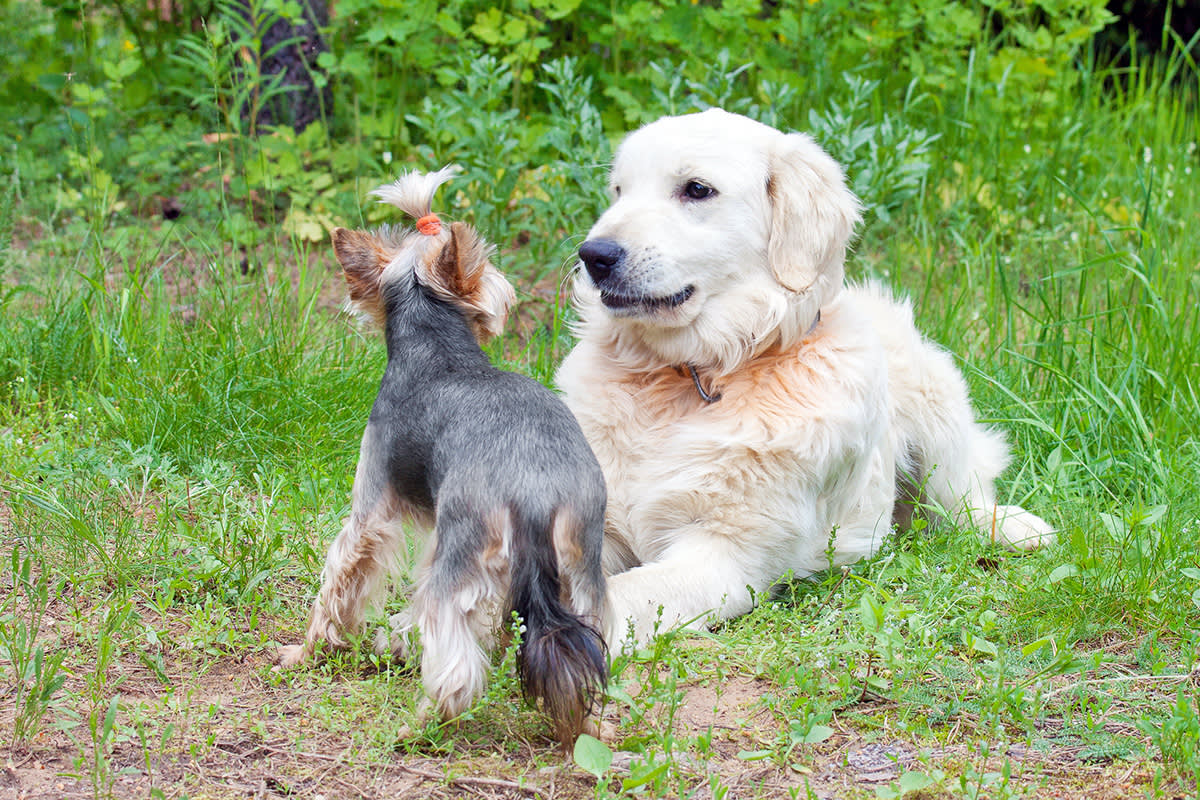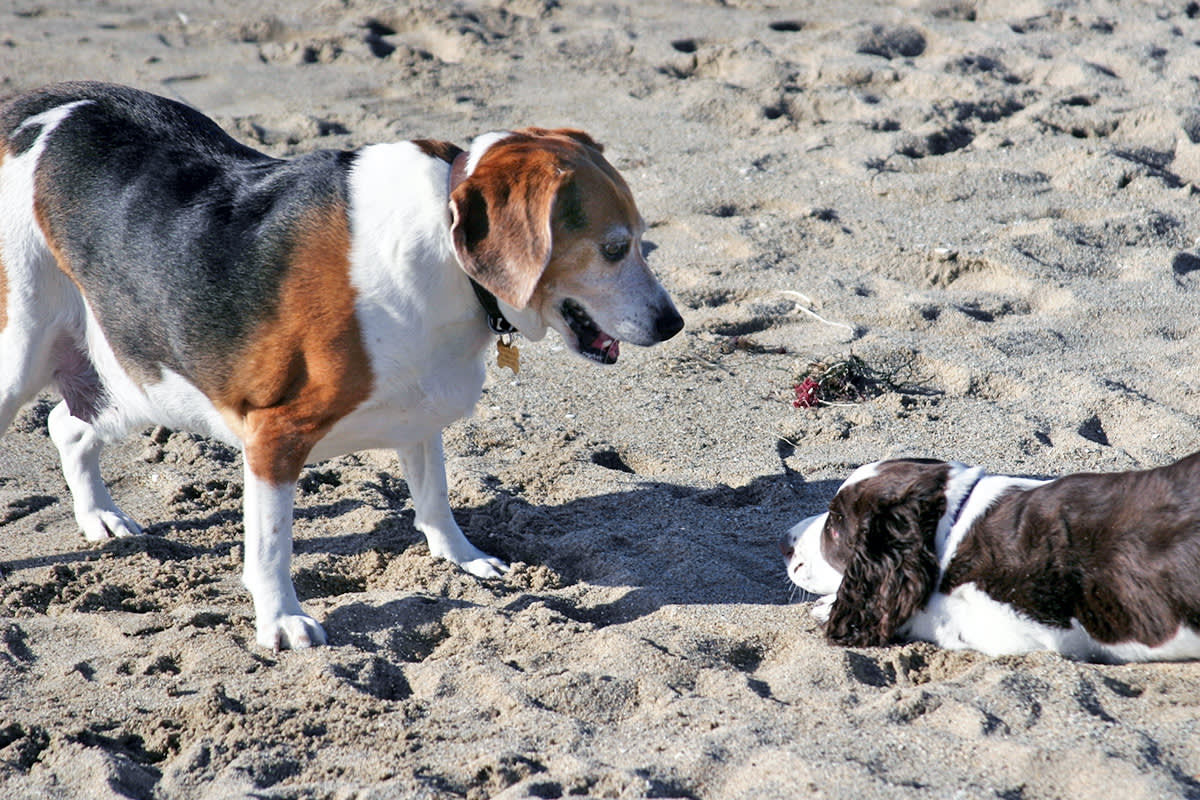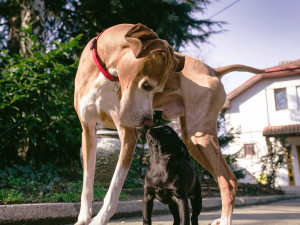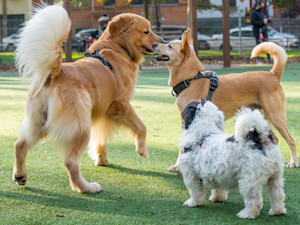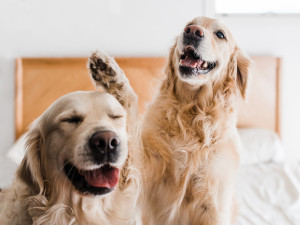Why Do Some Dogs Lie Down When They Greet Other Dogs?
Seems a little extra, tbh.
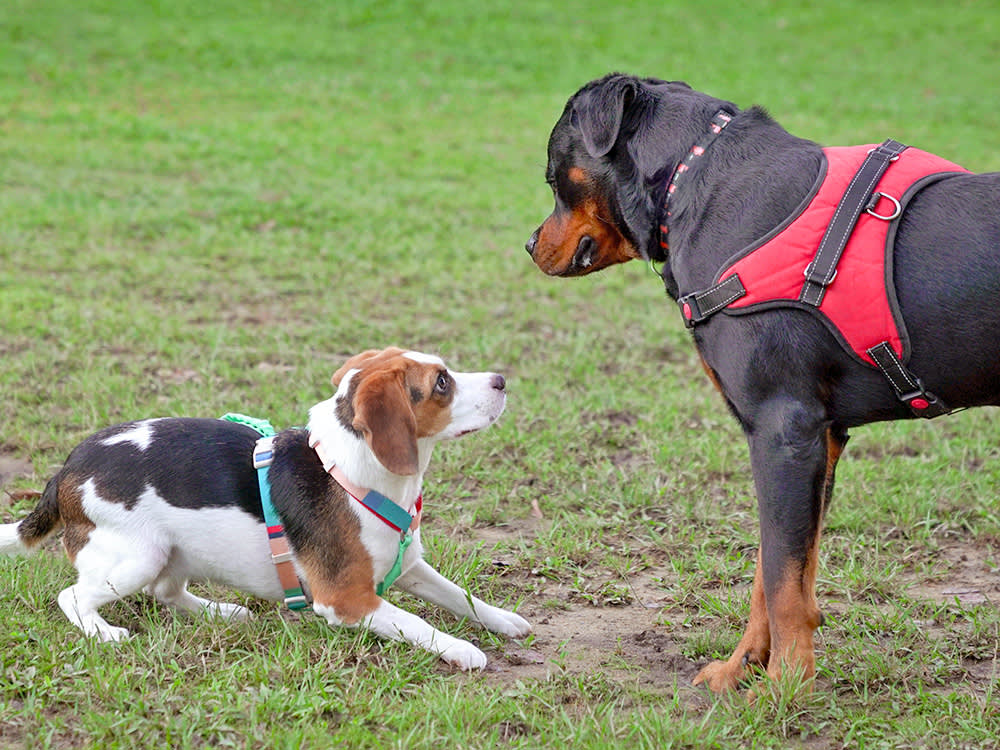
Share Article
Our dogs are inherently social creatures, but they don’t exactly have “social skills” — and this is part of what makes them great. I both admire and am jealous of the canine ability to waltz into a room, jump up on someone to say “hi,” flop on the floor and chew a toy, and then wander off to the next distraction, all the while charming everyone, save the lone Cruella de Vil-esque outlier in the room. (Some may call this “bad manners,” but I think it’s that canine je ne sais quoi. I, too, want to skirt social norms and be proclaimed adorable for it!)
When it comes to dog-to-dog socializing, there’s of course a whole unique world of social norms. While some gestures are canon (butt sniffing a standard greeting, “play stance” an invite to do just that), others are more inscrutable. For example, some dogs will lie down when they greet other dogs; mid-walk, they will simply lower down until they’re splayed on all fours on the sidewalk, and wait for the other dog to approach. But not all dogs do this, and the reception from the dog they’re greeting can be mixed: some interpret it as an invite to say “hi,” while others may perceive the low crouch as a threat.
Reddit user Superb_Tumbleweed_25 posted opens in new tab on r/dogadvice, inquiring what it might mean that their five-month-old Lab does this on walks: “She doesn’t pounce, she lets the other dog come over and sniff her while she stays down. I would say she does this with 75 percent of other dogs — some for whatever reason she will go right up to and say ‘hi.’ Is she trying to show the other dog she’s friendly?”
Some commenters thought the behavior was a sign of submissiveness, but that that’s not necessarily a positive thing. One user commented that they used to walk a dog who “rolled on her back for every other dog. But as she got older, she became very aggressive, just barking and trying to go at every single dog, even dogs that were walking by on the other side of the street and not even looking at her. These two different behaviors were both symptoms of her lack of confidence.”
How much do you spend on your pet per year?

Another commented that their dog also does this, but it’s followed by an intimidating lunge. “When he sees a dog, he’ll freeze, get down, then as they approach, lunge. If I let him lunge all the way he’ll just bark then be chill and sniff them, but it’s often really scary for other dogs and owners so I try to just not let him.”
One more user shared that their 115 pound Newfoundland/Pyrenees/Akbash does it as a sweet gesture, so as not to intimidate smaller dogs. “She always wants to be the first one to greet the new dogs at the dog park, and realized, pretty early, that a lot of smaller (most) dogs would get nervous to meet her and wouldn't want to play with her. Ever since she started her bowing routine, she hasn’t had a bit of trouble making friends.”
When your dog decides to plop down and have a tea party with every passing dog, it’s certainly charming at first, particularly if they’re a puppy (Look, Scruffy’s the mayor of the block!). But after the first few times, it can become a headache, when you’re just trying to make sure they do their business on a routine walk. And if it’s followed up by your dog pouncing on another, even if it’s in the name of play, it can sometimes give the wrong impression.
Here’s what dog behaviorists have to say about what’s behind the spontaneous sidewalk flop, and what dog owners can do if it starts to sabotage daily walks.
A genetic predisposition, or a strategy for playtime?
Dogs who crouch down when they see another dog, particularly herding breeds like Border Collies and Australian Shepherds, could be reenacting what’s known as the “prey sequence”, according to Maddie Messina, associate certified applied animal behaviorist and founder of Paws For Thought Dog Trainingopens in new tab.
If you’ve ever seen a video of a Collie herding sheep, you recognize this sequence: eye the sheep, orient, stalk, and chase. When our pets, who blessedly don’t have jobs, instinctively carry out such a heritable behavior, even though there are no sheep for miles, it’s known as a “fixed motor pattern,” Messina says. “It}s an incredibly inherited trait and it's really hard to train that out of them,” she explains.
For these herding breeds, playing is one way they practice the prey sequence, Messina says. So when you see a dog dropping to the ground and waiting for the other dog to approach, that could just be the (breed-specific) way they have fun.
In dogs without the herding link, dropping down in greeting could be an attempt at a standard “play bow”—front paws go down, butt up—but when restricted by the leash, it results in the dog “going full pancake,” says Robert Hausmann, certified dog trainer and founder of DogBoy NYCopens in new tab. “It could also be a body language cue that says, ‘I'm friendly and interested. I'm getting down low; I’m not a threat’.”
After enough successful sidewalk tea parties, the drop-and-wag becomes a “learned behavior” — put another way, that moment in the dog brain when it clicks: If I do this, I get what I want.
“It’s possible that the dog has learned through trial and error that refusing to move forward means they get to say hello,” Hausmann says. More power to them!
But what if you can’t make it around the block with your dog…
Even if it’s cute as heck that your pup wants to stop, drop, and socialize with other dogs, if it’s taking you half an hour just to get around the block, you may want to curb the behavior. “If I’m working with a client, I’ll tell them to try not to let it be successful,” he adds. “We don’t want to reinforce [the behavior].”
The next time your dog lies down in anticipation, don’t let them interact with the other dog. You might have to position yourself over your dog, and say to the approaching dog owner, “Sorry, we’re in training; we’re not saying ‘hi’ right now,” Messina suggests.
Of course, it’s not always easy to cajole your dog back up once they’re down. Messina has a few tips: using treats, you could teach your dog cues, like a “stand” cue, or “hand target,” where they touch their nose to your hand, which requires them to jump up to standing.
What if you’re approaching another dog who’s doing it?
Sometimes, the dog who’s crouching down will explode into play once the other dog gets close, and this could be seen as startling or threatening, depending on your dog’s disposition. If you’re at all apprehensive about how your dog or the other dog will react, you can opt to avoid the interaction by walking quickly past, or even crossing the street.
Or, simply communicate with the other dog’s parent first. Messina suggests asking, “Hey, are you OK with us approaching?” or “Does your dog enjoy playing with other dogs on leash?”
Walks are for walking, playtime is for playing.
“You can't start a game of football in math class,” says Hausmann, who’s a big proponent of setting boundaries between playtime and walk time.
��“I like to teach a dog that when we're walking together as a team, it doesn’t mean that they can't sniff and explore, but the focus is on us moving together through the environment,” Hausmann explains. The best way is to use treats to keep your dog attentive to you as you walk.
But make sure your dog does get ample opportunity for playing and socializing and “getting their yayas out,” says Hausmann — at the park, in the backyard, on play dates, or at daycare.
Your pup may also simply need a refresh on their walking skills. Hausmann suggests going on parallel walks with a friend and their dog, which can “help your dog learn how to walk through an environment in the presence of dogs where they can move in the same direction.” You could also work with a trainer, who might use a “helper dog” to pass your pup at a distance that then gets closer and closer as your dog learns to keep it moving.
Of course, in a perfect world, you instill these habits in your dog when they’re a puppy. You might decide early on that you won’t have your dog say “hi” to other dogs on walks.
“I tell clients, ‘I know it's really cute now, but when you're in a rush and your puppy’s [older] and they’re still laying down to say ‘hi’ to every dog they see, then you’re gonna be kicking yourself,” Messina says.
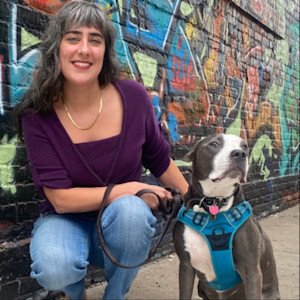
Kate Mooney
Kate Mooney is a Brooklyn-based writer with work in The New York Times, GQ, Vox, and more.
Related articles
![Big dog sniffs little dog in greeting]()
How to Properly Introduce Two Pups
There’s a lot more to it than sniffing each other’s butts.
![Dog in dark park]()
12 Signs You Shouldn’t Take Your Dog to the Dog Park
Just like not every person is into Coachella, not every pup wants to play in a crowd of dogs.
![Two Golden Retriever puppies playing with a large blue tennis ball outside in the grass]()
What to Expect at Puppy Socialization Classes
A dog behaviorist schools us on why puppy classes are more about socializing than getting straight As.
![Two happy Golden Retriever dogs sitting on the bed together]()
Do Dogs Have Besties?
They’re not exactly crafting friendship bracelets for each other, but dog bonds mean something.
![Two hands holding a very young tan and white puppy up in front of a lake landscape]()
How to Socialize a Puppy
Everything you need to know to get your new addition off to a good start.
